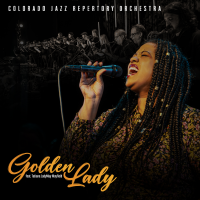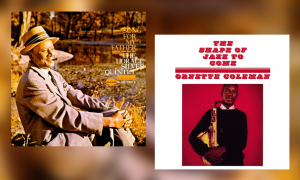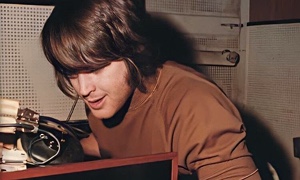Home » Jazz Articles » Building a Jazz Library » Sonny Rollins: Ten Colossal Albums
Sonny Rollins: Ten Colossal Albums

I tried to play for a long time before I realised I couldn't any more. People suggested electric instruments, but I just wanted to blow into the horn the way Coleman Hawkins did, Charlie Parker, John Coltrane, Lester Young. I was very distraught. Because all I ever wanted to do was play. It took me quite a while to find a way where I wouldn't end up in the insane asylum, to find another reason for living.
—Sonny Rollins (2022)
Born in 1930, Rollins grew up in Harlem, in Sugar Hill, a neighbourhood full of the city's best jazz musicians. By the time he was thirteen, he had already met Coleman Hawkins, the father of modern tenor saxophone playing. It was just a matter of waiting on Hawkins' doorstep with a pen and a glossy photograph. Around the same time, Rollins' neighbourhood friend, pianist Thelonious Monk, twelve years his elder, would smuggle Rollins underage into clubs. Rollins passed the Cotton Club every morning on his walk to school.
Growing up among the jazz musicians he venerated, Rollins had a geomusical advantage on the saxophonist most often touted as his rival. John Coltrane, four years his elder, was born in North Carolina in 1926, moved to Philadelphia in 1943, and did not settle in New York until the mid 1950s.
Rollins and Coltrane never considered themselves rivals in a Darwinian sense. There was a degree of competition between them, but above all they were good friends. Nonetheless, Rollins was boosted as the first "leader" in an entirely fictitious battle for supremacy which lasted until Coltrane passed in 1967. In the 1957 Downbeat critics' poll, Rollins was number one, Coltrane number two. (At this point Coltrane still did not have an album out under his own name, while Rollins had over ten). When Leonard Feather compiled his first jazz encyclopaedia in 1959, Rollins' entry was twice as long as Coltrane's.
Coltrane started to edge ahead in late 1959, when he recorded his breakthrough album, Giant Steps (Atlantic). Towards the end of the year, Rollins began a two-year sabbatical, partly, so the rumour mill had it, because he felt threatened by Coltrane's rise. Rollins has always denied this, doing so most recently in January 2022, in a lengthy interview he gave to the writer John Fordham for Britain's The Guardian newspaper. Rollins had withdrawn from the scene before and would do so again. In the early 1950s, after a heroin bust led to a stretch of hard-labour at the Lexington Narcotics Farm in Kentucky, Rollins delayed his return until he had freed himself from all mental and physical dependency on the drug. In 1968, he pursued spiritual pursuits in India for five months before abandoning music altogether from September 1969 to November 1971, spending much of his time studying meditation.
Rollins made his last great studio album, This Is What I Do (Milestone) in 2000, and 2006's Sonny, Please (Doxy) is also worthy of your attention. He continued playing until 2014, when pulmonary fibrosis forced him to stop. "Blowing the horn made me sick," he told John Fordham. "Believe me, I tried to play for a long time before I realised I just couldn't play any more. People suggested electric instruments, but I just wanted to blow into the horn the way Coleman Hawkins did, Charlie Parker, John Coltrane, Lester Young, all of these great people whose music still makes them feel alive to me, even though they're not here in the flesh. And I had that for a good portion of my life and I have accepted it now. But at first I was very distraught. It took me quite a while to find a way where I wouldn't end up in the insane asylum. Because all I ever wanted to do was play. It took me a while to find another reason for living, and I found it in meditation and eastern philosophies."
Rollins may not be playing anymore, but he is still very much with us. The interview in The Guardian demonstrates that, as does the characteristically insightful thoughts Rollins shared with producer Zev Feldman for the Albert Ayler box set Revelations: The Complete ORTF 1970 Fondation Maeght Recordings (Elemental, 2022) and which Zeldman has included in the box's booklet. Rollins is still part of our jazz world. He always will be.
Sonny Rollins: Ten Colossal Albums
These albums are listed in chronological order of recording, which is not in every case the order in which they were released. Sonny Rollins
Sonny Rollins Tenor Madness
Prestige, 1956
Rollins recorded six albums for Prestige during 1956. Tenor Madness was recorded in May with Miles Davis' rhythm section—pianist Red Garland, bassist Paul Chambers and drummer Philly Joe Jones—and was his breakthrough disc. On each of the six albums, Rollins' muscular lyricism is in top form, but Tenor Madness was the first to be celebrated beyond the immediate circle of Rollins' admirers. The reason: John Coltrane, who was hanging out at Rudy Van Gelder's studio with his fellow Davis sidemen, and happened to have his tenor with him, was invited by Rollins to join him on the title track. He plays seven choruses, Rollins plays eight, and then the two trade back and forth. In truth, the meeting is historic less for the duo's performances than because it is their only recorded encounter. Incidentally, "Tenor Madness," a fast blues riff, is credited to Rollins on the sleeve, but it had in fact been recorded by bands led by drummers Kenny Clarke in 1946 (as "Royal Roost") and by Art Blakey in 1955 (as "Sportin' Crowd").
Rollins' soulful, bluesy solo on "Tenor Madness," rich with blue notes and bent notes, compares well with Coltrane's rather clinical approach. Elsewhere, Rollins motivic style—which would be dubbed "thematic improvisation" by the musicologist Gunther Schuller in 1957—shines, particularly on his original "Paul's Pal" and Richard Rodgers' "The Most Beautiful Girl In The World." Tenor Madness deserves its reputation.
Rollins' first stone masterpiece, however, was recorded a month later....
 Sonny Rollins
Sonny Rollins Saxophone Colossus
Prestige, 1957
The crown jewel among the albums Rollins made for Prestige in 1956 is Saxophone Colossus, recorded in June. It is, indisputably, one of the greatest tenor saxophone albums of all time. Rollins fronts a quartet completed by pianist Tommy Flanagan, bassist Doug Watkins and drummer Max Roach. He sounds even better than he did just a month before—Promethean, exultant, a force of nature.
In addition to Rollins' sonic mastery, Saxophone Colossus stands out for two other reasons. "St Thomas," named after the Caribbean island on which his mother was born, is his first full-on exploration of calypso, which became a permanent strand in his music. And on the minor blues "Blue 7," another original, and other tracks, Rollins brings to a new level Gunther Schuller's thematic improvisation. Rollins' solos on the album, Schuller observed, have sufficient invention and coherence to hold together as compositions themselves. A third original, "Strode Rode," features a saxophone and drums conversation which bears comparison with any of the legendary exchanges between Charles Mingus and Dannie Richmond or John Coltrane and Elvin Jones. It pretty much goes without saying that Rollins makes the two covers—Don Raye and Gene Du Paul's "You Don't Know What Love Is" and Kurt Weill's "Moritat" (aka "Mack The Knife")—entirely his own.
 Sonny Rollins
Sonny Rollins Tour De Force
Prestige, 1957
Of all the albums Rollins recorded in 1956, Tour De Force is in 2022 perhaps the least widely celebrated. It is, however, every bit as good as Tenor Madness and almost as good as Saxophone Colossus. Like those albums, it features a quartet, this one completed by Max Roach, pianist Kenny Drew and bassist George Morrow.
Recorded six months after Colossus in December 1956, Tour De Force is unusual for the presence of a singer, Earl Coleman, who is heard on two ballads, Al Frisch and Sid Wayne's "Two Different Worlds" and Richard Whiting and Newell Chase's "My Ideal." Rollins adds gorgeous solos to both. But it is the other three tracks, the turbo-charged originals "Ee-Ah," "B. Quick" and "B. Swift," which conjure the most powerful magic. Rollins' wilder-than-wild solos practically tear Rudy Van Gelder's studio apart. The relentlessly abrasive nature of these three tracks—thrown into stark relief by the Earl Coleman ballads—asked too much of Rollins' late 1950s audience, which pretty much passed it over. Tour De Force, however, cries out for reconsideration.
 Sonny Rollins
Sonny Rollins Way Out West
Contemporary, 1957
Recorded in March 1957, Way Out West was the first album Rollins recorded with just bass and drums. The piano-less format freed him from the changes-based structures a keyboard instrument more or less imposes and, starting right here, it has produced some of his finest work.
The album was recorded in Los Angeles during Rollins' first visit to California, with bassist Ray Brown and drummer Shelley Manne, neither of whom Rollins had ever played with before. All three musicians had been working in clubs earlier in the night, and so the session began at 3am, continuing until around lunchtime the next day. Despite these circumstances—or perhaps because of them—Way Out West is a killer.
Way Out West contains two Rollins originals, "Come, Gone" and "Way Out West," and four covers. Two of these, Duke Ellington's "Solitude" and Isham Jones' "There Is No Greater Love," are jazz standards. The other two, Johnny Mercer's "I'm An Old Cowhand" and Billy Hill's "Wagon Wheels," are novelty-tune hokey, and respectively opened sides one and two of the original LP, establishing the relaxed, amiable mood which runs through the album. Rollins had a unique ability to make great jazz out of the corniest material—playing it affectionately rather than for snide laughs—and he returned to this strand winningly many times on future albums.
 Sonny Rollins
Sonny Rollins Newk's Time
Blue Note, 1959
Recorded in 1957 two months before A Night At The Village Vanguard (see below), Newk's Time was not released until 1959.
Listening to almost any Rollins album, one may be reminded of a story attaching to the cricketer W.G. Grace, who dominated the English game in the late Victorian era and is credited with having invented modern batsmanship. At an exhibition match in 1901, Grace was bowled out during the opening minutes but refused to leave the pitch. "People have come to watch me bat, not you bowl," he said. The umpire had little choice but to let Grace remain at the crease.
Rollins seems to have displayed a similar attitude with some of the distinctly underwhelming bass and drums players who accompanied him on European tours in the late 1970s and 1980s. The people had, indeed, come to hear Rollins play and, providing the rhythm section kept time and kept out of his way, it did not really matter how good or otherwise they were.
There is nothing underwhelming about the rhythm section on Newk's Time—pianist Wynton Kelly, bassist Doug Watkins and drummer Philly Joe Jones—and Kelly and Jones (who solos or trades with Rollins on each of the six tracks) are in fine form. But one nonetheless cannot help wishing Rollins would stay on mic throughout, so magnificent does he sound. The standout track is the 6:43 minute reading of Richard Rodgers' "The Surrey With The Fringe On Top." Kelly and Watkins lay out and for all but just over a minute, Rollins is centre stage, giving us a reprise of his treatment of "I'm An Old Cowhand" and "Wagon Wheels" on the aforementioned Way Out West. Magic.
 Sonny Rollins
Sonny Rollins A Night At The Village Vanguard
Blue Note, 1957
New York's Village Vanguard has been the location of some of jazz's greatest live albums and the earliest of these is Rollins' A Night At The Village Vanguard. It was recorded on November 3, 1957, just months after owner Max Gordon's adoption of a jazz booking policy, and the album is up there with other treasures such as John Coltrane's Live At The Village Vanguard (Impulse) and Bill Evans' Sunday At The Village Vanguard (Riverside), both recorded in 1961. The combination of Gordon's evangelical attitude towards jazz, and the knowledgeable audience base he developed, seemed to bring out the best in musicians right up until he passed in 1989.
Another album made with just bass and drums, in its extended and audio improved 2 x CD RVG edition, A Night At The Village Vanguard includes two tunes from the afternoon set (Dizzy Gillespie's "A Night In Tunisia" and Cole Porter's "I've Got You Under My Skin") and most of the evening's first and second sets. On the afternoon tracks, Rollins is accompanied by bassist Donald Bailey and drummer Pete La Roca, and during the evening by Wilbur Ware and Elvin Jones.
There are two originals—"Sonnymoon For Two" and "Striver's Row"—and the rest of the time Rollins weaves his spell on a mix of jazz standards and show tunes, including Oscar Hammerstein's "Softly As In A Morning Sunrise" and "All The Things You Are," Don Raye's "I'll "Remember April," Harold Arlen's "Get Happy," Miles Davis' "Four" and Gillespie's "Woody 'n You" and the aforementioned "A Night In Tunisia" (two versions, the second from the evening).
 Sonny Rollins
Sonny Rollins Freedom Suite
Riverside, 1958
The third album in this top ten made with just bass and drums, this time with Oscar Pettiford and Max Roach. Freedom Suite shows that, while Coltrane was edging ever closer to his coronation, Rollins was still the one stretching the envelope furthest. The album opens with a twenty-minute suite, some seven years before Coltrane's A Love Supreme (Impulse, 1965)—though to be fair, Coltrane's suite is not only twice as long, it is also more ambitiously structured.
More meaningfully, a case can be made for Freedom Suite being the first explicitly political extended work to emerge from New York's burgeoning "new thing" scene; the next significant event would be Max Roach's own We Insist! Freedom Now Suite (Candid, 1960). Just in case there was any misunderstanding about the import of "The Freedom Suite," Rollins included this statement on the LP's rear sleeve: "America is deeply rooted in Negro culture; its colloquialisms, its humor, its music. How ironic that the Negro, who more than any other people can claim America's culture as its own, is being persecuted and repressed, that the Negro, who has exemplified the humanities in his very existence, is being rewarded with inhumanity."
Rollins' statement seemingly created such a furore amongst the white critics who constituted jazz's media gatekeepers, that Riverside pulled Freedom Suite and rereleased it under the title Shadow Waltz, the second shortest track on the album. For the reissue, the label's co-owner Orrin Keepnews wrote a new set of sleeve notes that went into contortions to deny that "The Freedom Suite" had any special relevance to black people. Instead, Keepnews maintained that the title had in mind freedom "in general." Not surprisingly, Rollins did not again record for Riverside.
 Sonny Rollins
Sonny Rollins The Bridge
RCA Victor, 1962
In 1959, Rollins began a two-year sabbatical, a response, it was said at the time, to Coltrane's meteoric ascent. But in the interview Rollins gave to Britain's The Guardian in January 2022, Rollins explained things differently. "I was getting a lot of publicity for my work at that time," he said. "But I wasn't satisfying my own requirements for what I wanted to do musically"—his withdrawal from the scene had little if anything to do with Coltrane. Given Rollins' attitude towards his art, as well as his relationship with Coltrane, this is a convincing explanation. Anyway, over the next two years, Rollins took to practicing alone on the pedestrian footbridge on the East River's Williamsburg Bridge, where he could play as long and as loud as liked. By late 1960, a legend had grown up around this and, inevitably, when Rollins released his comeback album, recorded in 1961, it was titled The Bridge.
The album does not reveal the radically reinvented Rollins, leaning towards à la mode free jazz, that some observers had been forecasting (1963's unimpressive RCA album Our Man In Jazz, with Don Cherry on cornet, took a halfstep in that direction, but Rollins did not repeat it). Instead, Rollins plays with robust, classical lyricism on his customary mix of originals and standards.
Still eschewing a piano, Rollins fronts a quartet completed by guitarist Jim Hall, bassist Bob Cranshaw and drummer Ben Riley (replaced on Arthur Herzon's "God Bless The Child" by Harry Saunders). Hall's inclusion is inspired. The following year, the guitarist would record his first masterpiece, Undercurrent (United Artists), with Bill Evans, and he is nimble enough to make his own mark without getting in the way of Rollins, who interacts with him closely throughout. The album is almost (almost) as much Hall's as it is Rollins.'
 Sonny Rollins
Sonny Rollins On Impulse!
Impulse, 1965
Rollins made three albums for Impulse in the mid-1960s. On Impulse!, in 1965, and Alfie and East Broadway Run Down, both in 1966. The winner, by three falls, a submission and a knockout, is On Impulse!.
Rollins fronts a quartet with pianist Ray Bryant, bassist Walter Booker and drummer Mickey Roker. There are five tracks, all of them covers, and the highlights are probably (it is a close call) the eleven-minute reading of Tom Adair's "Everything Happens To Me," on which Rollins, Bryant and Booker each solo beautifully, Harry Thomas' calypso "Hold 'Em Joe" and Harry Ruby's "Three Little Words." Rollins is in exalted form and Bob Thiele and Rudy Van Gelder's work compares well with the sometimes merely adequate studio sound Rollins was given on the RCA Victor albums which preceded it (George Avakian's production of the aforementioned The Bridge passes muster).
East Broadway Run Down is the next of the Impulses to check. It teams Rollins with trumpeter Freddie Hubbard, bassist Jimmy Garrison and drummer Elvin Jones, but somehow, despite the personnel, it just does not quite make it. Alfie is OK so far as it goes, but, while Rollins' score (the soundtrack for the movie of the same name), is interesting, it is performed by a medium-size ensemble and there is not enough of Rollins' saxophone for the album to qualify for this top ten.
 Sonny Rollins
Sonny Rollins This Is What I Do
Milestone, 2000
The majority of Rollins' finest work was made in the 1950s and 1960s. From that time on, although practically all of his albums contain at least one track of brilliance, overall the discs are patchy. Some of the best work from this latter period can be heard on the 2 x CD Milestone compilation, Silver City, released in 1996, which covers the years 1972 to 1995.
As though to demonstrate he could still turn it out when he wanted to, in 2000 Rollins made his late period masterpiece. On This Is What I Do, he leads a quintet comprising trombonist Clifton Anderson, pianist Stephen Scott, bassist Bob Cranshaw (first encountered here on 1962's The Bridge, and in 2000 playing electric bass), and alternating drummers Jack DeJohnette and Perry Wilson. It is the best band Rollins had assembled for some time. There are six tracks. Each of them is a blinder and it is hard to pick out favourites, but "A Nightingale Sang In Berkeley Square," (coincidentally a tune Pharoah Sanders returned to at about the same time) and two new Rollins originals, the calypso "Salvador" and the tribute "Did You Hear Harold Vick?," are classics. Another solid album, Sonny, Please followed on Doxy in 2006.
The final word goes to Ira Gitler, who in 1958 described Rollins' sound thus: "At the (Village) Vanguard, Rollins exhibited that staggering brand of gigantic tenor that makes you feel as if you are the instrument being played. The music does more than surround you with grandeur; it gets into your circulatory system and courses through your body." Now as then, that nails it.
Tags
PREVIOUS / NEXT
Support All About Jazz
 All About Jazz has been a pillar of jazz since 1995, championing it as an art form and, more importantly, supporting the musicians who make it. Our enduring commitment has made "AAJ" one of the most culturally important websites of its kind, read by hundreds of thousands of fans, musicians and industry figures every month.
All About Jazz has been a pillar of jazz since 1995, championing it as an art form and, more importantly, supporting the musicians who make it. Our enduring commitment has made "AAJ" one of the most culturally important websites of its kind, read by hundreds of thousands of fans, musicians and industry figures every month.

























